Real-Time Interface Model Investigation for MCFC-MGT HILS Hybrid Power System
Abstract
:1. Introduction
2. Model Description
2.1. Model Object
2.2. Mathematical Model
2.2.1. Basic Equations
2.2.2. Compressor Model
2.2.3. Turbine Model
2.2.4. MCFC Model
- All the gases are ideal gases;
- The temperature of the fuel cell is equal with the temperature of cathode exit and anode exit;
- The energy storage of gas and the heat exchange with the atmosphere are ignored;
- The average feature of the gases is consistent with the exit feature.
2.2.5. Heat Exchanger Model
3. Model Validation
4. Simulation Results and Discussion
4.1. The Step-Down of the MCFC Current Density
4.2. The Step-Up of the MCFC Current Density
5. Conclusions
Author Contributions
Funding
Conflicts of Interest
Nomenclature
| density (kg/m3) | N2 | nitrogen (-) | |
| velocity (m/s) | p | pressure (Pa) | |
| specific volume (m3/kg) | Pdc | output power of fuel cell stack (W) | |
| specific heat capacity ratio (-) | qc | heat exchange of cool side (W) | |
| pressure ratio (-) | qh | heat exchange of hot side (W) | |
| adiabatic efficiency (-) | Qw | heat flow (W) | |
| Ac | heat exchange area of the cool side (m2) | r1 | reforming reaction rate (mol/s) |
| Ah | heat exchange area of the hot side (m2) | ra | polarization resistance of the anode (Ω) |
| C | mole quality per unit volume (mol/m3) | rc | polarization resistance of the cathode (Ω) |
| CH4 | methane (-) | rohm | internal resistance of the fuel cell (Ω) |
| CO | carbon monoxide (-) | R | ideal gas constant (8.314 J/mol·K) |
| CO2 | carbon dioxide (-) | Ra(c),i | reaction rate of all reactions (mol/s) |
| Cpm | specific heat capacity of metal (J/(kg·K)) | t | time (s) |
| Cps | specific heat capacity of the fuel cell stack (J/(kg·K)) | T | temperature (K) |
| DEN | defined parameter (-) | Ts | fuel cell stack temperature (K) |
| E | Nernst equation (V) | V | control volume of the channel (m3) |
| E0 | standard potential voltage (V) | Vcell | voltage of the fuel cell (V) |
| F | faraday constant (C/mol) | wc | power consumption of the adiabatic entropy increase process (kW) |
| Fa,c | mole flow rate (mol/s) | wc,s | power consumption of the adiabatic isentropic process (kW) |
| Fw | friction force (N) | x | mole fraction (-) |
| g | standard gravity (9.81 m/s2) | Z | elevation (m) |
| GAS | collection of all gases (-) | ||
| h | specific enthalpy (kJ/kg) | Subscripts | |
| H2 | hydrogen (-) | w | wall |
| H2O | water vapor (-) | 0 | ideal conditions |
| J | current density (A/m2) | a | anode |
| k | practical form loss factor (-) | c | cathode |
| k1 | reaction constant of the reforming reaction (-) | i | seven different gas species |
| K | Stodola coefficient | s | fuel cell stack |
| KCH4 | gas adsorption constant of methane (-) | hot | hot side |
| KCO | gas adsorption constant of carbon monoxide (-) | cl | cool side |
| KH2 | gas adsorption constant of hydrogen (-) | m | metal |
| KH2O | gas adsorption constant of steam (-) | ||
| Kp1 | equilibrium constant of the reforming reaction (-) | Superscripts | |
| Kshift | equilibrium constant of water-gas shift reaction (-) | in | inlet |
| m | mass flow (kg/s) | o | outlet |
| Mm | mass of metal (kg) | r | reaction |
| Ms | mass of the fuel cell stack (kg) | ||
Appendix A
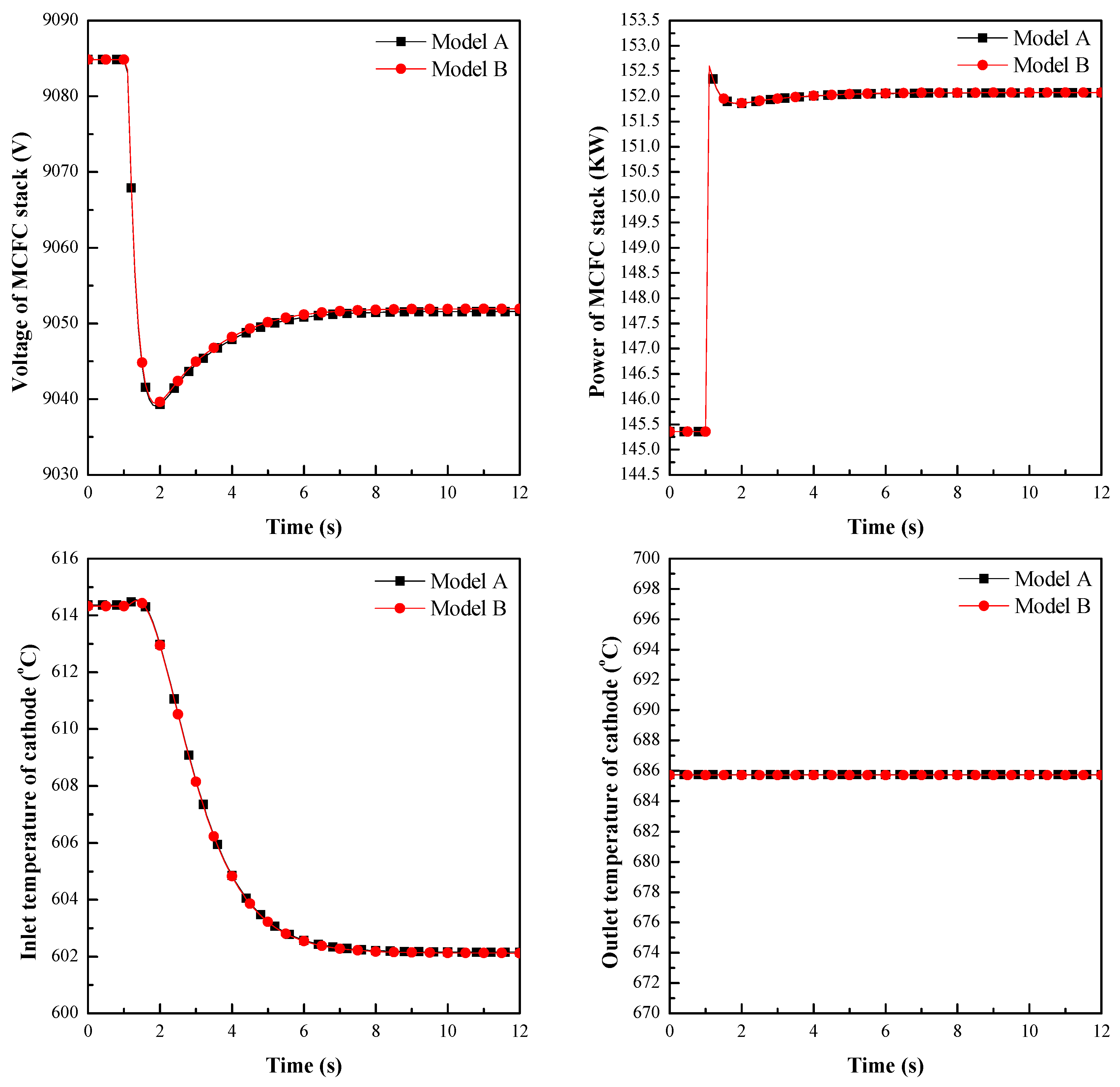
References
- Milewski, J.; Discepoli, G.; Desideri, U. Modeling the performance of MCFC for various fuel and oxidant compositions. Int. J. Hydrogen Energy 2014, 39, 11713–11721. [Google Scholar] [CrossRef]
- Gopisetty, S.; Treffinger, P. Generic Combined Heat and Power (CHP) Model for the Concept Phase of Energy Planning Process. Energies 2017, 10, 11. [Google Scholar] [CrossRef]
- Huang, H.; Li, J.; He, Z.; Zeng, T.; Kobayashi, N.; Kubota, M. Performance Analysis of a MCFC/MGT Hybrid Power System Bi-Fueled by City Gas and Biogas. Energies 2015, 8, 5661–5677. [Google Scholar] [CrossRef] [Green Version]
- Liu, A.; Bing, W.; Wen, Z.; Chen, B.; Weng, Y. Catalytic combustion and system performance assessment of MCFC-MGT hybrid system. Int. J. Hydrogen Energy 2014, 39, 7437–7446. [Google Scholar] [CrossRef]
- Liu, A.; Weng, Y. Performance analysis of a pressurized molten carbonate fuel cell/micro-gas turbine hybrid system. J. Power Sour. 2010, 195, 204–213. [Google Scholar] [CrossRef]
- Veyo, S. Westinghouse Fuel Cell Combined Cycle Systems; Office of Scientific & Technical Information Technical Reports: Pittsburgh, PA, USA, 1996. [Google Scholar]
- Wee, J.-H. Molten carbonate fuel cell and gas turbine hybrid systems as distributed energy resources. Appl. Energy 2011, 88, 4252–4263. [Google Scholar] [CrossRef]
- Lorenzo, G.D.; Fragiacomo, P. A methodology for improving the performance of molten carbonate fuel cell/gas turbine hybrid systems. Int. J. Energy Res. 2012, 36, 96–110. [Google Scholar] [CrossRef]
- Ghezel-Ayagh, H.; Walzak, J.; Junker, S.T.; Patel, D.; Michelson, F.; Adriani, A. DFC/T® Power Plant: From Sub-Megawatt Demonstration to Multi-Megawatt Design. ECS Trans. 2008, 12, 713–717. [Google Scholar]
- Ghezel-Ayagh, H.; Walzak, J.; Patel, D.; Daly, J.; Maru, H.; Sanderson, R.; Livingood, W. State of direct fuel cell/turbine systems development. J. Power Sour. 2005, 152, 219–225. [Google Scholar] [CrossRef]
- Kyrychko, Y.N.; Blyuss, K.B.; Gonzalez-Buelga, A.; Hogan, S.J.; Wagg, D.J. Real-time dynamic substructuring in a coupled oscillator–pendulum system. Proc. R. Soc. A Math. Phys. Eng. Sci. 2006, 462, 1271–1294. [Google Scholar] [CrossRef]
- Hao, H.; Zhang, H.; Weng, S.; Ming, S. Dynamic numerical simulation of a molten carbonate fuel cell. J. Power Sour. 2006, 161, 849–855. [Google Scholar]
- Yang, F.; Zhu, X.-J.; Cao, G.-Y. Temperature control of MCFC based on an affine nonlinear thermal model. J. Power Sour. 2007, 164, 713–720. [Google Scholar] [CrossRef]
- Said, S.B.; Saad, K.B.; Benrejeb, M. HIL simulation approach for a multicellular converter controlled by sliding mode. Int. J. Hydrogen Energy 2017, 42, 12790–12796. [Google Scholar] [CrossRef]
- Haghighatkhah, A.; Banijamali, A.; Pakanen, O.P.; Oivo, M.; Kuvaja, P. Automotive software engineering: A systematic mapping study. J. Syst. Softw. 2017, 128, 25–55. [Google Scholar] [CrossRef]
- Tauzia, X.; Karaky, H.; Maiboom, A. Evaluation of a semi-physical model to predict NOx and soot emissions of a CI automotive engine under warm-up like conditions. Appl. Therm. Eng. 2018, 137, 521–531. [Google Scholar] [CrossRef]
- Park, J.I.; Park, H.E.; Park, S.Y.; Choi, K.H. Hardware-in-the-loop simulations of GPS-based navigation and control for satellite formation flying. Adv. Space Res. 2010, 46, 1451–1465. [Google Scholar] [CrossRef]
- Al-Jarrah, M.A.; Hasan, M.M. HILS setup of dynamic flight path planning in 3D environment with flexible mission planning using Ground Station. J. Frankl. Inst. 2011, 348, 45–65. [Google Scholar] [CrossRef]
- Ayasun, S.; Fischl, R.; Vallieu, S.; Braun, J.; Çadırlı, D. Modeling and stability analysis of a simulation–stimulation interface for hardware-in-the-loop applications. Simul. Modell. Pract. Theory 2007, 15, 734–746. [Google Scholar] [CrossRef]
- Lukas, M.D.; Lee, K.Y.; Ghezel-Ayagh, H. An Explicit Dynamic Model for Direct Reforming Carbonate Fuel Cell Stack. IEEE Power Eng. Rev. 2001, 21, 63. [Google Scholar] [CrossRef]
- Roberts, R.A.; Jabbari, F.; Brouwer, J.; Gemmen, R.S.; Liese, E.A. Inter-Laboratory Dynamic Modeling of a Carbonate Fuel Cell for Hybrid Application. In Proceedings of the 2003 International Joint Power Generation Conference, Atlanta, GA, USA, 16–19 June 2003; pp. 565–572. [Google Scholar]
- Law, M.C.; Lee, C.C.; Tay, C.L. Dynamic behaviors of a molten carbonate fuel cell under a sudden shut-down scenario: The effects on temperature gradients. Appl. Therm. Eng. 2015, 82, 98–109. [Google Scholar] [CrossRef]
- Lee, C.-W.; Lee, M.; Yoon, S.-P.; Ham, H.-C.; Choi, S.H.; Han, J.; Nam, S.W.; Yang, D.-Y. Study on the effect of current collector structures on the performance of MCFCs using three-dimensional fluid dynamics analysis. J. Ind. Eng. Chem. 2017, 51, 153–161. [Google Scholar] [CrossRef]
- Corporation, C.T. Technical Reference: Capstone Model C30 Performance; Capstone Turbine Corporation: Chatsworth, CA, USA, 2006. [Google Scholar]
- Lukas, M.D.; Lee, K.Y.; Ghezel-Ayagh, H. Development of a stack simulation model for control study on direct reforming molten carbonate fuel cell power plant. IEEE Trans. Energy Convers. 1999, 14, 1651–1657. [Google Scholar] [CrossRef]
- Jurado, F.; Saenz, J.R. Adaptive control of a fuel cell-microturbine hybrid power plant. In Proceedings of the IEEE Power Engineering Society Summer Meeting, Chicago, IL, USA, 21–25 July 2002; Volume 1, pp. 76–81. [Google Scholar]
- Roberts, R.A.; Brouwer, J.; Liese, E.; Gemmen, R.S. Dynamic simulation of carbonate fuel cell-gas turbine hybrid systems. J. Eng. Gas Turbines Power 2006, 128, 294–301. [Google Scholar] [CrossRef]
- McLarty, D.; Brouwer, J.; Samuelsen, S. Fuel cell–gas turbine hybrid system design part II: Dynamics and control. J. Power Sour. 2014, 254, 126–136. [Google Scholar] [CrossRef]
- Bedont, P.; Grillo, O.; Massardo, A.F. Off-Design Performance Analysis of a Hybrid System Based on an Existing MCFC Stack. J. Eng. Gas Turbines Power 2003, 125, 387–395. [Google Scholar] [CrossRef]
- Siikonen, T. Numerical method for one-dimensional two-phase flow. Numer. Heat Trans. Appl. 1987, 12, 1–18. [Google Scholar]
- Duan, J.; Sun, L.; Wang, G.; Wu, F. Nonlinear modeling of regenerative cycle micro gas turbine. Energy 2015, 91, 168–175. [Google Scholar] [CrossRef]
- Stodola, A. Steam and Gas Turbines; Peter Smith: New York, NY, USA, 1945; Volume 1. [Google Scholar]
- Xu, J.; Froment, G.F. Methane Steam Reforming, Methanation and Water-Gas Shift: I. Intrinsic Kinetics. AiChe J. 1989, 35, 88–96. [Google Scholar] [CrossRef]
- Koh, J.-H.; Seo, H.-K.; Yoo, Y.-S.; Lim, H.C. Consideration of numerical simulation parameters and heat transfer models for a molten carbonate fuel cell stack. Chem. Eng. J. 2002, 87, 367–379. [Google Scholar] [CrossRef]
- Hirschenhofer, J.H.; Stauffer, D.B.; Engleman, R.R.; Klett, M.G. Fuel Cell Handbook; Business/Technology Books: Morgantown, VA, USA, 1998. [Google Scholar]


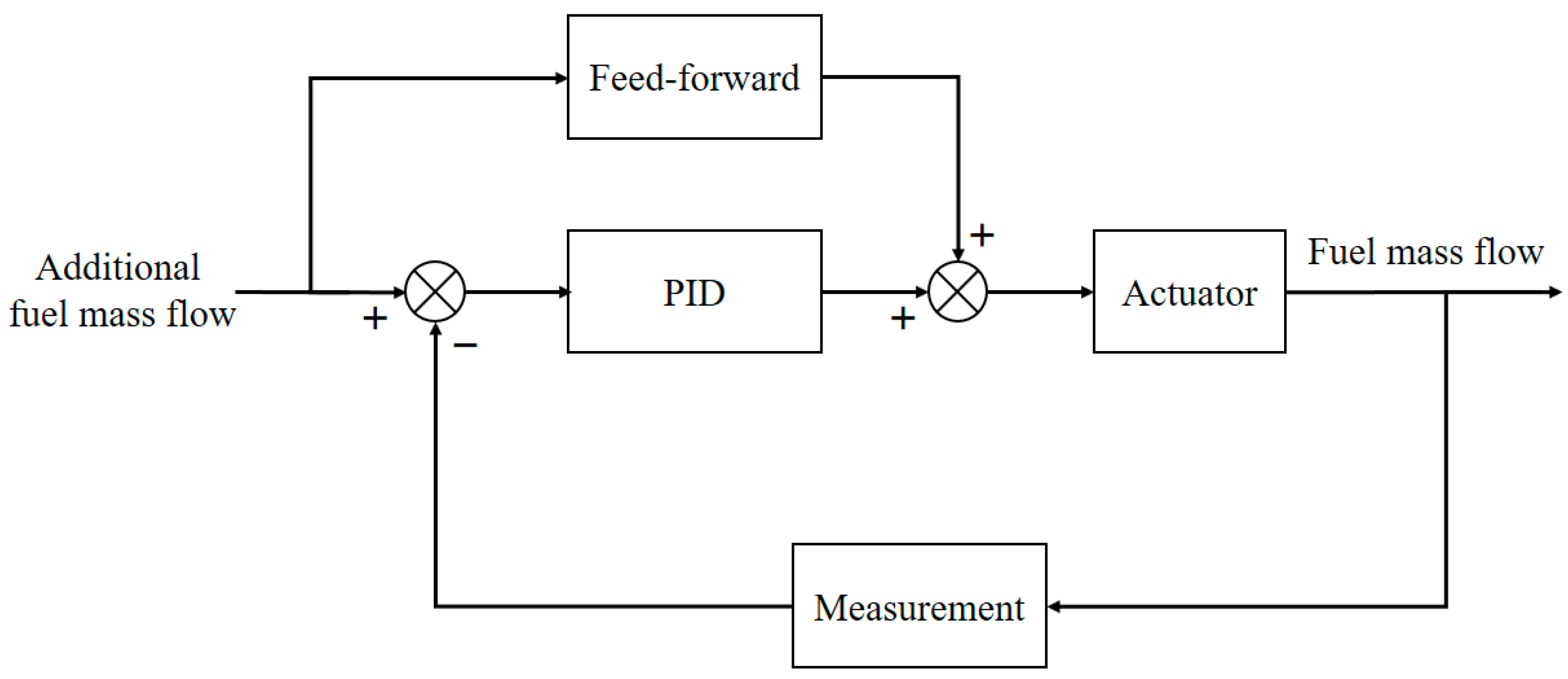
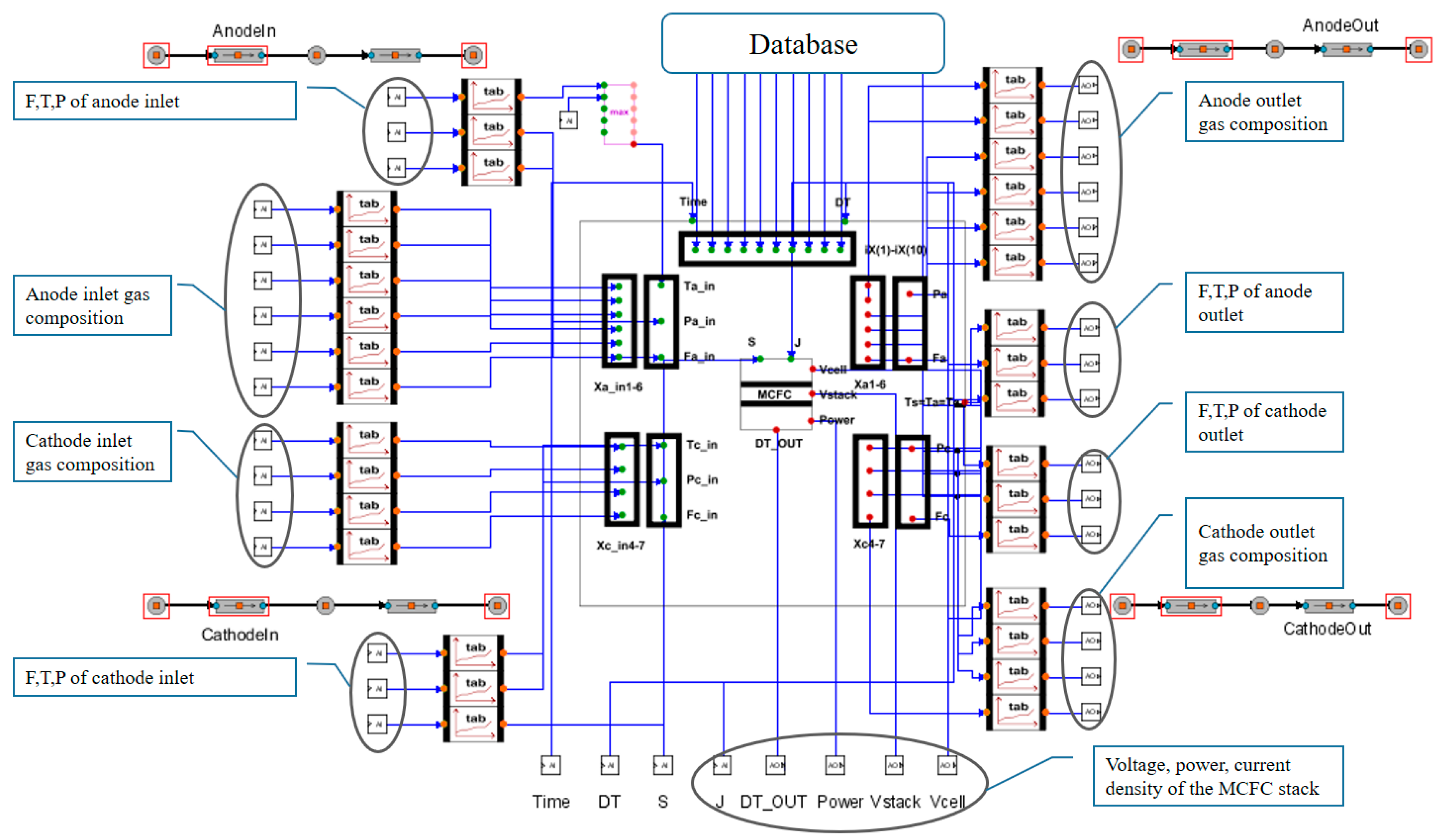

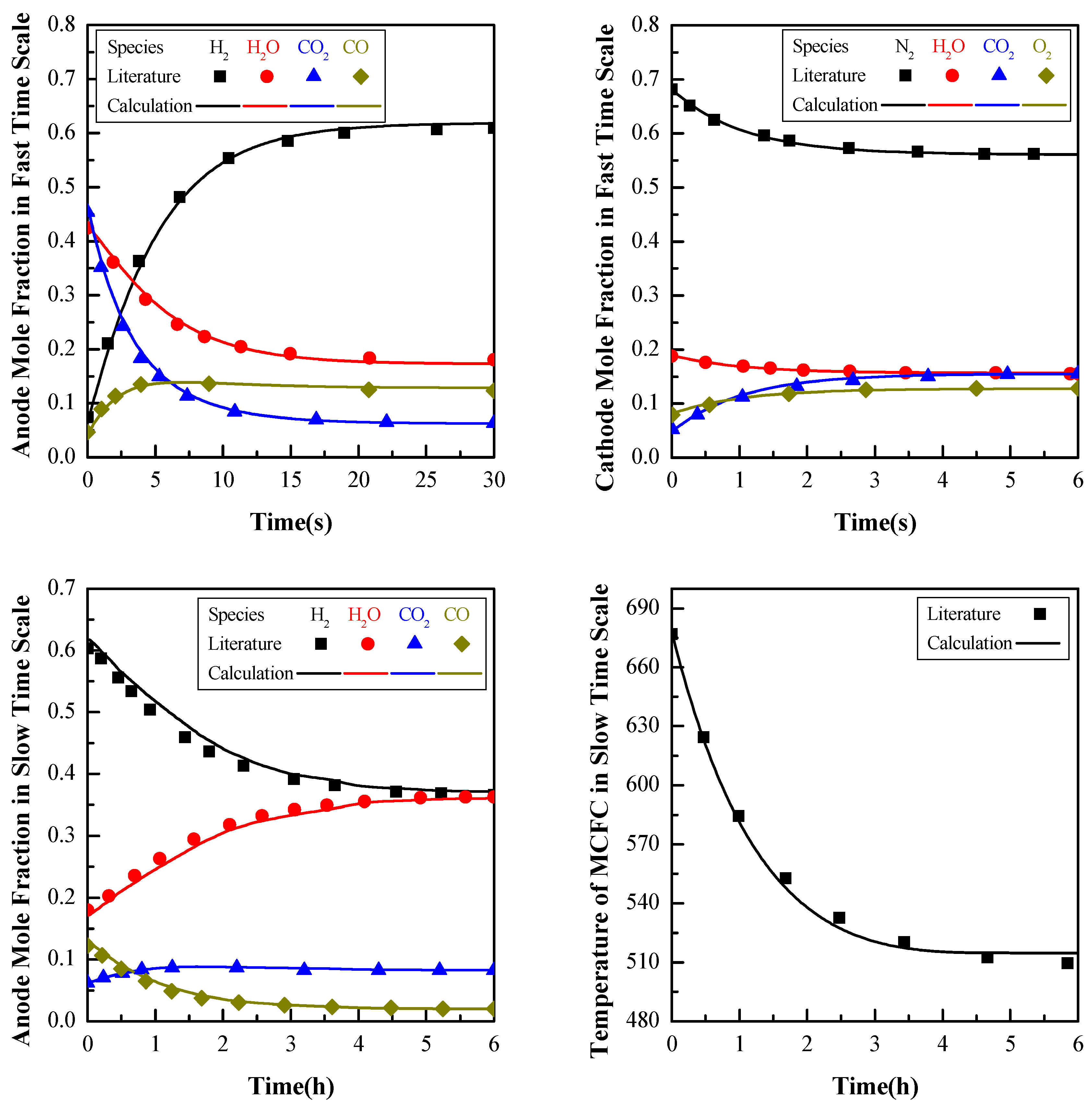
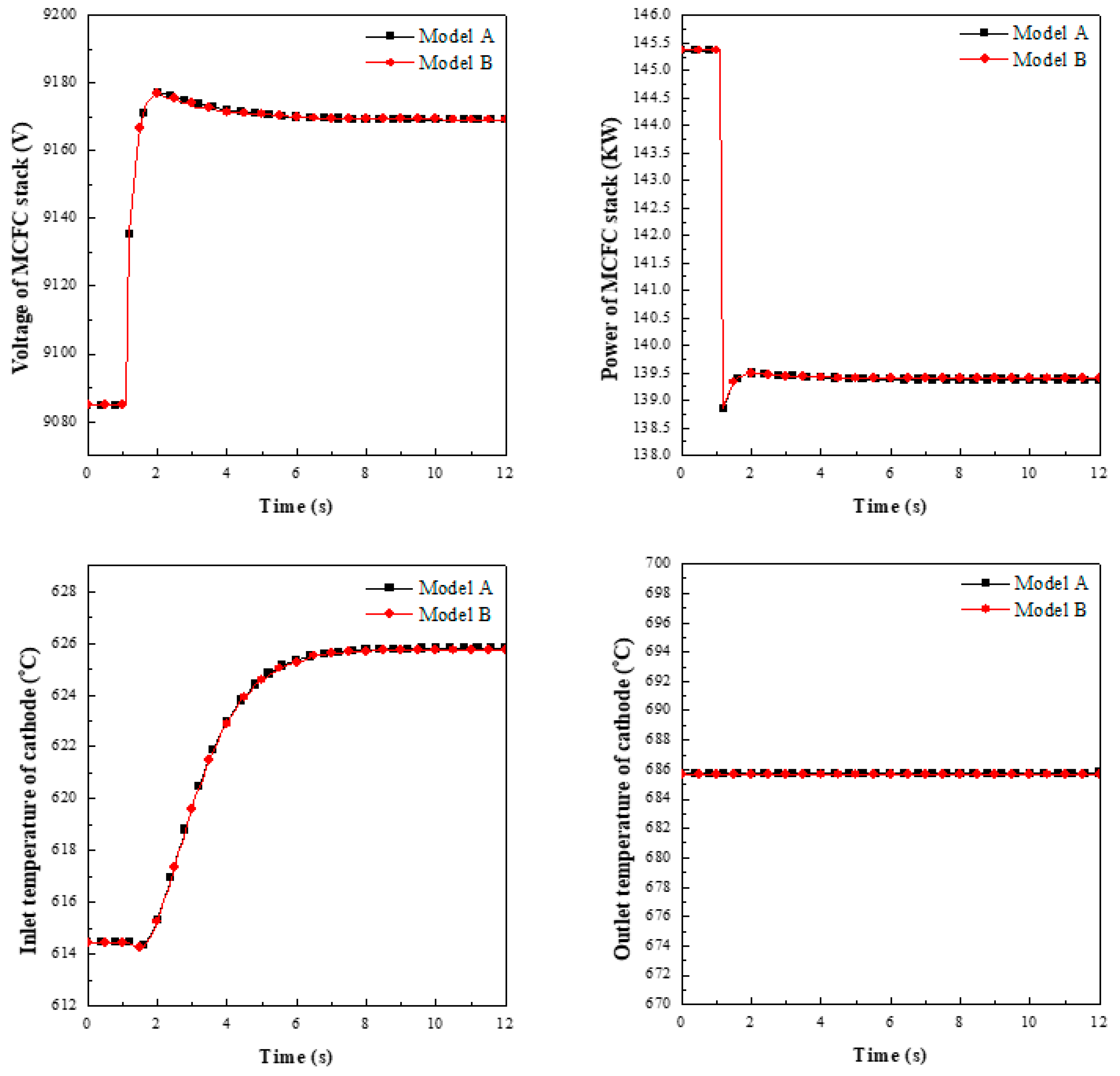
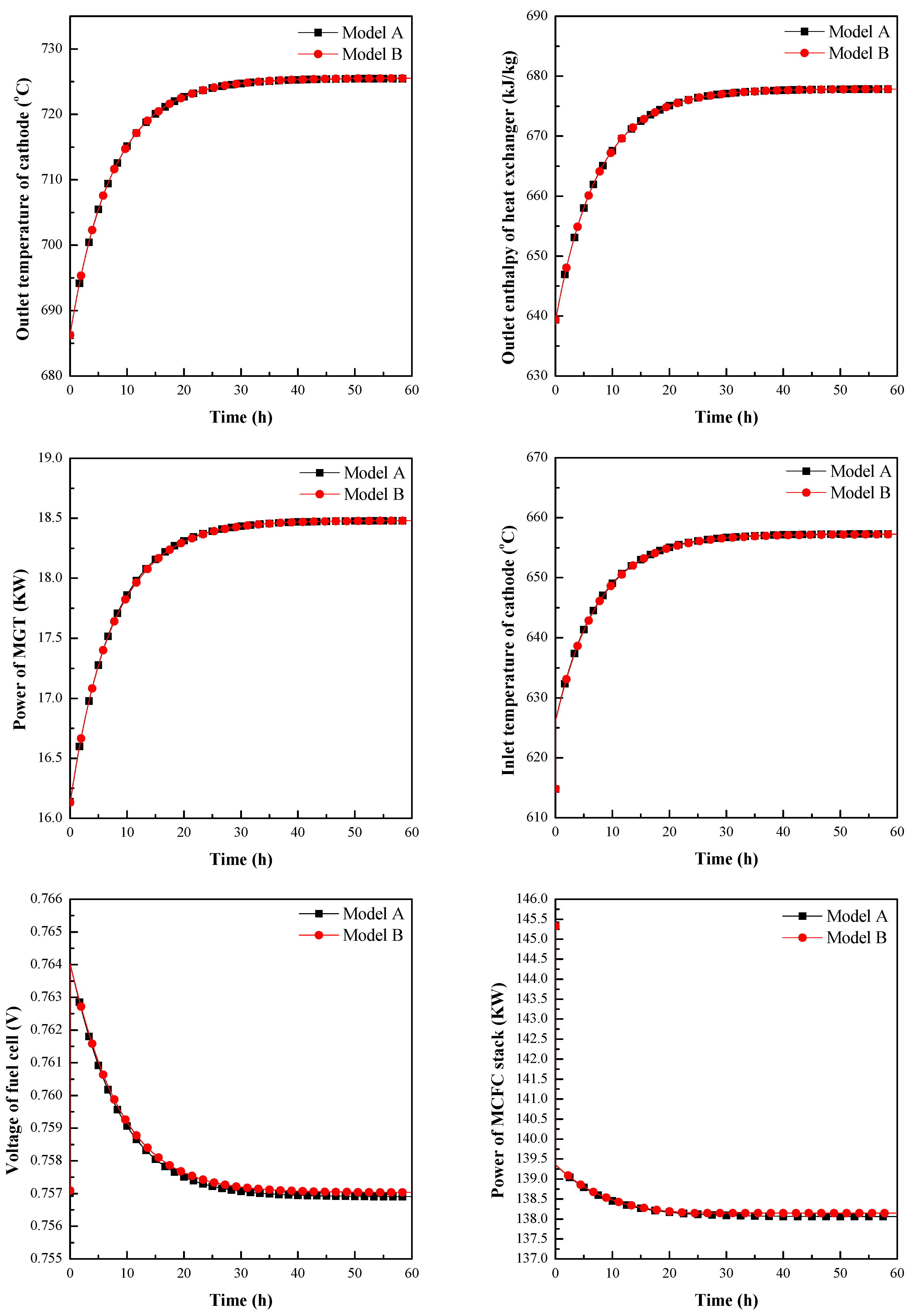
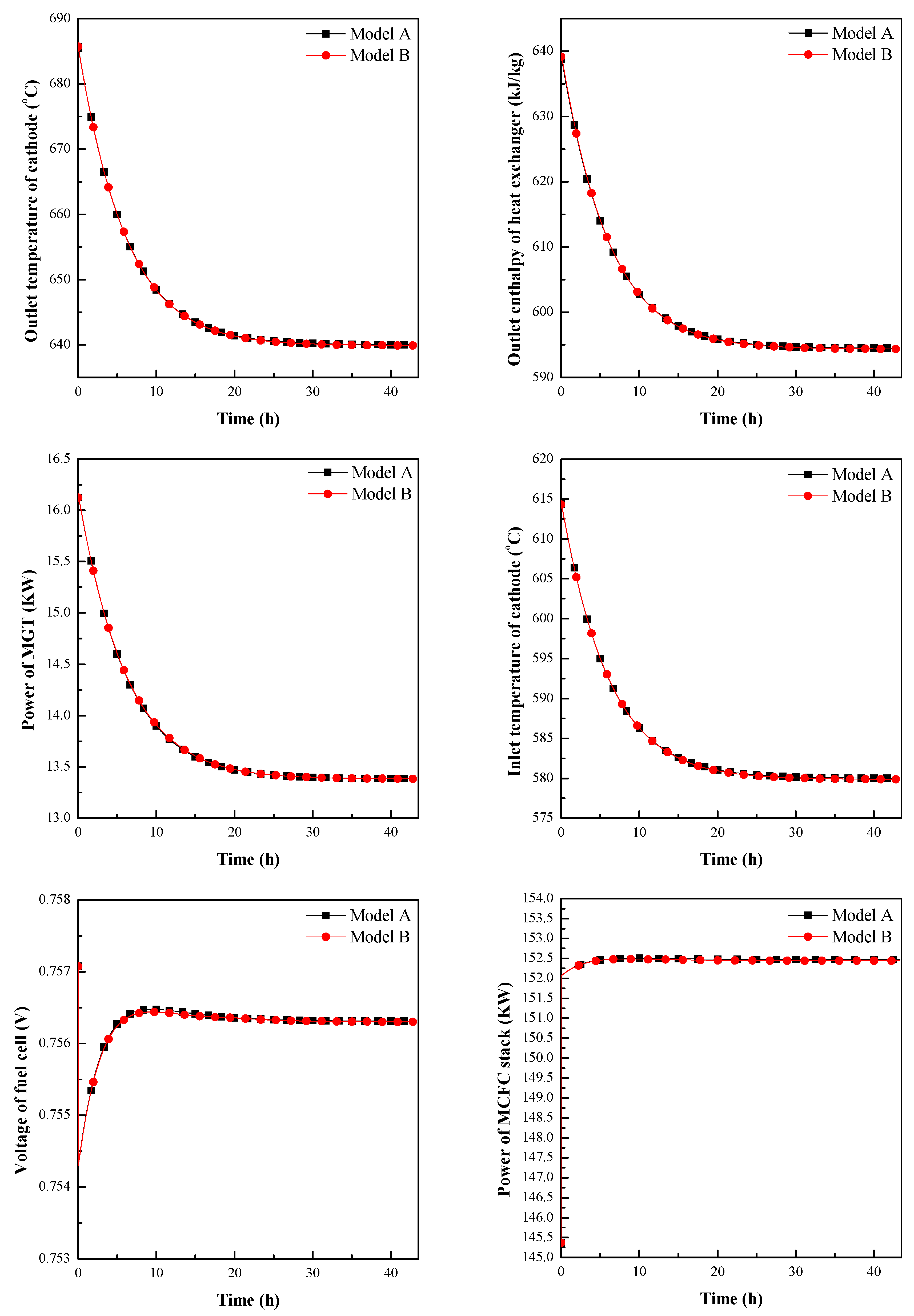
| Parameter | Value | Unit |
|---|---|---|
| Compressor inlet temperature | 15 | °C |
| Compressor inlet pressure | 0.97 | bar |
| Fuel inlet temperature | 25 | °C |
| Fuel inlet pressure | 3.57 | bar |
| Parameter | Simulation Result | Design Value | Unit | Relative Error |
|---|---|---|---|---|
| Compressor outlet temperature | 157.6 | 153 | °C | 3.01% |
| Compressor outlet pressure | 3.1 | 3.1 | bar | 0.00% |
| Compressor flow rate | 0.31 | 0.31 | kg/s | 0.00% |
| Fuel inlet flow rate | 0.0024 | 0.0024 | kg/s | 0.00% |
| Combustor outlet temperature | 822.2 | 840 | °C | −2.12% |
| Combustor outlet pressure | 2.89 | 2.89 | bar | 0.00% |
| Turbine inlet temperature | 822.2 | 840 | °C | −2.12% |
| Turbine outlet temperature | 615 | 620 | °C | −0.81% |
| Power | 29.63 | 30 | MW | −1.23% |
| Parameter | Simulation Result | Literature | Unit | Relative Error |
|---|---|---|---|---|
| Gross DC Power | 2294 | 2295 | kW | −0.04% |
| The Temperature of Stack | 676.99 | 677.00 | °C | 0.00% |
| Mole Friction of CH4 at the Anode Exit | 0.001089 | 0.0011 | / | −1.00% |
| Mole Friction of CO at the Anode Exit | 0.046112 | 0.0462 | / | −0.19% |
| Mole Friction of H2 at the Anode Exit | 0.074027 | 0.0741 | / | −0.10% |
| Mole Friction of CO2 at the Anode Exit | 0.453903 | 0.4533 | / | 0.13% |
| Mole Friction of H2O at the Anode Exit | 0.428700 | 0.4245 | / | 0.99% |
| Mole Friction of CO2 at the Cathode Exit | 0.047637 | 0.0476 | / | 0.08% |
| Mole Friction of H2O at the Cathode Exit | 0.187948 | 0.1880 | / | −0.03% |
| Mole Friction of N2 at the Cathode Exit | 0.676758 | 0.6778 | / | −0.15% |
| Mole Friction of O2 at the Cathode Exit | 0.087658 | 0.0865 | / | 1.34% |
© 2019 by the authors. Licensee MDPI, Basel, Switzerland. This article is an open access article distributed under the terms and conditions of the Creative Commons Attribution (CC BY) license (http://creativecommons.org/licenses/by/4.0/).
Share and Cite
Yang, C.; Deng, K.; He, H.; Wu, H.; Yao, K.; Fan, Y. Real-Time Interface Model Investigation for MCFC-MGT HILS Hybrid Power System. Energies 2019, 12, 2192. https://doi.org/10.3390/en12112192
Yang C, Deng K, He H, Wu H, Yao K, Fan Y. Real-Time Interface Model Investigation for MCFC-MGT HILS Hybrid Power System. Energies. 2019; 12(11):2192. https://doi.org/10.3390/en12112192
Chicago/Turabian StyleYang, Chen, Kangjie Deng, Hangxing He, Haochuang Wu, Kai Yao, and Yuanzhe Fan. 2019. "Real-Time Interface Model Investigation for MCFC-MGT HILS Hybrid Power System" Energies 12, no. 11: 2192. https://doi.org/10.3390/en12112192





